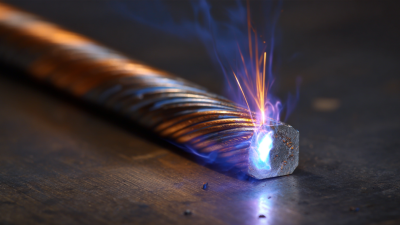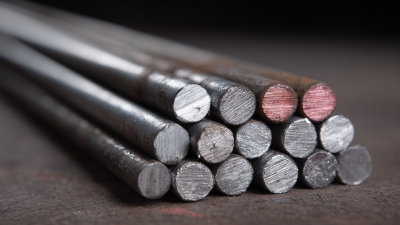How to Choose and Use the Right 308 Welding Rod for Your Projects
Table of Contents
- Understanding the Different Types of 308 Welding Rods Available
- Key Factors to Consider When Selecting a 308 Welding Rod
- Step-by-Step Guide on How to Properly Use 308 Welding Rods
- Common Challenges and Solutions When Welding with 308 Rods
- Maintenance Tips for Extending the Life of Your 308 Welding Rods
- Comprehensive Guide to AWS A5.4 E308L-16 Stainless Steel Welding Electrodes for Superior Arc Welding
- FAQS
- Conclusion
- Related Posts
When it comes to welding, picking the right materials is pretty much everything—it's key to making sure your joints are solid and last a long time. Among all the options out there, the 308 Welding Rod really stands out because of how versatile and reliable it is. I've read that more and more welders are turning to 308 rods lately, mainly because they work well in all kinds of situations, especially when you're dealing with stainless steel. Wenzhou Tianyu Electronic Co., Ltd., which has been around since 2000, has been a main player in making top-notch welding electrodes and consumables for over 22 years. They really specialize in stainless steel, carbon steel, and low alloy electrodes, and they stick to strict quality standards to keep up with modern welding needs. If you know how to choose and use the right 308 Welding Rod, it can seriously boost the quality and efficiency of your welding projects. In the end, that means safer, more reliable structures—pretty important, right?

Understanding the Different Types of 308 Welding Rods Available
When you're choosing a 308 welding rod for your project, it's really helpful to understand the different types out there because each one is designed for specific materials and purposes. Basically, 308 rods are mainly used for welding stainless steel, especially the low-carbon kinds. According to the American Welding Society (AWS), you'll often see types like 308L and 308H. The 'L' stands for low carbon, which is great because it helps reduce the risk of carbide precipitation during welding. On the other hand, 308H is better suited for high-temperature stuff since it has higher heat resistance.
There are also other variations, like 308Si rods, which include silicon. That little addition makes the weld flow better and actually looks nicer. Industry folks say that choosing the right rod can really boost your productivity and improve the quality of your welds. For example, using a 308L can give you around a 30% increase in corrosion resistance compared to generic or non-specialized rods. So, knowing the ins and outs of these rods—their composition and what they’re best for—really helps you get better results, tailored to what your project needs.

Key Factors to Consider When Selecting a 308 Welding Rod
When you're picking out a 308 welding rod for your projects, there are a few key things to keep in mind to get the best results. First off, making sure it’s compatible with your base material is super important. Generally, the 308 rod is great for welding stainless steels — especially the 304 grade. So, it’s a good idea to check what your materials are made of, just to be sure the 308 rod is the right fit for what you're working on. Knowing the chemistry of your materials can really save you from headaches later on, like issues with weak fusion or corrosion down the line.
Another thing to think about is the welding process you’re using. Whether you're doing MIG, TIG, or something else, different methods might need specific types or sizes of rods. It’s worth making sure you pick a rod that lines up with your welding technique so your welds turn out strong and clean. Plus, factors like how thick your materials are, the design of the joint, and the angle you're welding from can all influence which rod size or type you should choose. Taking all these things into account will help you make smarter choices and get better, more reliable results in the end.
Welding Rod Selection Factors
Step-by-Step Guide on How to Properly Use 308 Welding Rods
When you're working with 308 welding rods, it’s really important to know how to use them right to get strong, clean welds. First off, take a moment to set up your workspace. Make sure the area is free of dirt, grease, or anything that could mess with your welds. Don’t forget your safety gear—gloves, goggles, and a welding helmet should definitely be part of your kit. Before you start welding, wipe down the metal to get rid of rust, oil, or paint, because those contaminants can seriously weaken your welds.
Next, set your welding machine to the right amperage for your specific 308 rods. It’s super important to keep your hand steady and hold the right angle while welding — this helps you get good penetration and a nice, even bead. Keep an eye on the arc length throughout; it should stay pretty steady to make sure you’re using the right heat and getting a solid weld.
**Tips:** If you're working with thin metal, stick to a stringer bead because it cuts down on distortion. For thicker stuff, a weaving motion can help fill in better and ensure a solid bond. And hey, don’t be afraid to practice on some scrap pieces first. It’s the perfect way to figure out your settings and get comfortable before diving into your real project — no pressure!
Common Challenges and Solutions When Welding with 308 Rods
When you're working with 308 welding rods, it's pretty common to run into a few issues that can mess with the quality of your welds. One of the biggest problems is porosity — you know, those tiny holes or bubbles that can pop up because of bad technique or contamination. To avoid that, make sure the surfaces are super clean before you start—no grease, rust, or moisture lurking around. Also, keeping the right arc length and moving at the right speed can really help to prevent trapped gases from ruining your weld.
Another tricky part is cracks forming, especially when welding thicker materials. A good trick here is preheating the metal beforehand — it helps reduce stress and makes sure everything fuses together nicely. After you finish welding, cooling things down gradually can also cut down on cracking issues. If you keep an eye on these common problems and follow some simple steps, you'll end up making much stronger and more dependable welds with your 308 rods.

Maintenance Tips for Extending the Life of Your 308 Welding Rods
If you want your 308 welding rods to last longer, good care and storage are pretty much essentials. First off, make sure you keep your electrodes somewhere dry—moisture is the enemy here, as it can cause contamination and mess with your weld quality. Some folks swear by using a rod oven before they start welding; it helps keep everything dry and can give you better results.
Also, handle those rods gently to avoid any accidental chips or dents. It’s a good idea to check them over regularly—look for any signs of wear or defects before you get started. Don’t forget to clean your work area and use proper techniques while welding, as this can really help extend the life of your electrodes.
Here at Wenzhou Tianyu Electronic Co., Ltd., we’ve been making top-notch welding electrodes for over 22 years. We really recommend following these little maintenance tips to get the best possible results for your projects. Our focus on quality means our stainless steel and other welding supplies are built to last and perform reliably, no matter what kind of welding job you’re tackling.
Comprehensive Guide to AWS A5.4 E308L-16 Stainless Steel Welding Electrodes for Superior Arc Welding
When it comes to superior arc welding, choosing the right welding electrode is paramount. The AWS A5.4 E308L-16 stainless steel welding electrode stands out due to its ultra-low carbon composition and titanium-calcium coating. Specifically designed for welding austenitic stainless steels, E308L-16 provides excellent resistance to corrosion and oxidation, making it ideal for applications in chemical processing, food production, and wastewater treatment industries. According to industry reports, the E308L-16 is recommended for its ability to maintain mechanical properties at elevated temperatures, ensuring structural integrity even in rigorous environments.
The A002 (AWS E308L-16) electrode excels in versatility and performance. With a chromium content of 19% and nickel content of 10%, it promotes optimal weld bead formation and weld pool fluidity. The low carbon content significantly reduces the risk of carbide precipitation during and after welding, which is critical for maintaining corrosion resistance in welded joints. Data from the American Welding Society highlights that electrodes with such composition yield superior impact strength and toughness, particularly in applications subjected to cryogenic conditions. By incorporating the A002 electrode into your welding processes, you can achieve high-quality welds that meet strict industry standards and enhance the longevity of your projects.
FAQS
: 308 welding rods are primarily designed for welding stainless steel, especially those with a low carbon content.
The "L" in 308L welding rods indicates low carbon content, which is suitable for reducing the risk of carbide precipitation during welding.
The 308H welding rods are designed for high-temperature applications due to their higher heat resistance.
308Si rods incorporate silicon to improve fluidity and enhance the appearance of the weld.
Choosing the right welding rod can significantly impact productivity and weld quality; for example, using a 308L rod can lead to a 30% increase in corrosion resistance compared to non-specialized rods.
To maintain the life of 308 welding rods, store them in a dry environment, avoid moisture absorption, handle them carefully to prevent physical damage, and inspect them regularly for defects.
Using a rod oven before use can help keep the electrodes dry, enhancing their performance during welding.
Cleaning the welding area and using appropriate techniques during the welding process are crucial aspects that contribute to the longevity of the electrodes.
Wenzhou Tianyu Electronic Co., Ltd. has over 22 years of experience in producing high-quality welding electrodes.
The company is committed to quality, designing their stainless steel and other types of welding consumables for durability and reliability in various welding applications.
Conclusion
When you're picking out the right 308 welding rod for your project, it’s super helpful to get a good grasp of the different types out there and what they’re best for. I mean, stuff like what kind of material you’re welding, how strong the weld needs to be, and the environment you’re working in all matter big time. Using the right rod properly is key, so following a simple step-by-step guide can really help you get those perfect results.
Welding with 308 rods can sometimes throw a few challenges your way—yeah, I’ve been there. But don’t worry, knowing some common solutions makes tackling those issues way easier. Also, don’t forget that taking good care of your welding rods and doing regular maintenance can really make them last longer, which is honestly a smart move for anyone into welding. At Wenzhou Tianyu Electronic Co., Ltd., with over 22 years of experience making top-notch welding electrodes, we’re dedicated to providing high-quality welding consumables, including 308 rods, to make sure you get exactly what you need for your project.
Related Posts
-

7 Essential Tips for Maximizing Efficiency with 308 Welding Rods in Industrial Applications
-

Unmatched Quality of Best Aluminum Welding Electrode from China to the World
-

Future Innovations in Welding: The Rise of Best Welding Cast Aluminum by 2025
-

How to Choose the Best Aluminum Stick Welding Rod for Your Projects
-

Mastering Hard Facing Techniques with the Best Hard Facing Welding Rods for Superior Durability
-

What Makes the Best Stick Welding Rods Stand Out in Today’s Market
Blog Tags:


